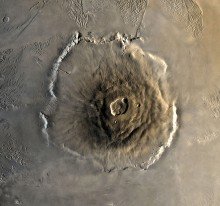To get straight to the point (at the top, get it?), it’s Olympus Mons, on Mars. And it’s around two and a half times as tall as Mount Everest. It’s nearly 22km high (13.6 miles) compared to Mount Everest’s piddly 8.8km (5.5 miles).
Olympus Mons is a volcano, the youngest one on Mars. In fact, over half of the surface of Mars is covered by lava.
Image by NASA, modifications by Seddon
The main caldera (which is the name given to the large volcanic craters bit) alone is about 80km (50 miles) wide. You can see this in the image above which was taken by Viking 1 orbiter. In fact, this summit is formed of six nested calderas forming a total depression approximately 60 km (37 miles) × 80 km (50miles) across.
Olympus Mons is what is known as a shield volcano because its profile is generally wide and low, resembling a warrior’s shield lying on the ground. Albeit a massive warrior’s shield. I mean, I wouldn’t want to meet that warrior on a dark night. Ahem, I digress. Back to the subject in hand.
The entire mountain covers an area about the size of Italy, about 300,000 km2(120,000 square miles) (Frankel, C.S. (2005). Worlds on Fire: Volcanoes on the Earth, the Moon, Mars, Venus and Io; Cambridge University Press: Cambridge, UK, p. 132. ISBN 978-0-521-80393-9).
Interestingly, if you stood on the summit, you would not know you were standing on a very high mountain. The shallow slope of the volcano would extend far beyond the horizon, the horizon being just 3km away (Martian Volcanoes on HST Images How Far Could I See Standing on Olympus Mons, “2.37 miles”, Jeff Beish, Former A.L.P.O. Mars Recorder Archived August 27, 2009, at the Wayback Machine).
Mars itself has a very dusty surface, the soil of which containing iron oxide, giving the planet its distinctive rusty red colour. It is also the outermost rocky planet from our Sun. It is the second smallest planet in the Solar System, coming in at 6,792km (4,220 miles) wide at the equator. It is about half the size of Earth which is 12,756km (7,926 miles) wide at the equator. Interestingly, because it has no surface water, Mars has about the same total area of land as Earth.
Graham Foster
Founder of Mind Rocket.
View the original article here.
Visit www.mindrocket.co.uk for more amazing science facts.
Also please Like the Mind Rocket Facebook page to get science facts every day.












